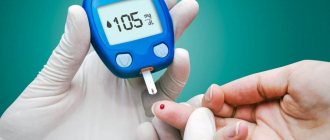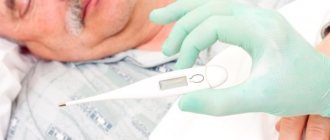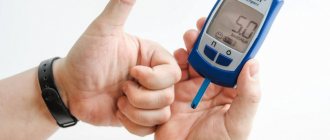Classification
According to severity, hyperglycemia is divided into:
- Light
– up to 8.2 mmol/l. - Moderate –
from 8.3 to 11 mmol/l. - Severe –
over 11 mmol/l.
This numerical division is considered very conditional, since it is not the level of glycemia that is of greater importance, but the rate of increase. Based on their nature, hyperglycemia is classified into physiological (stress, carbohydrate intake) and pathological hyperglycemia. According to the origin of hyperglycemia, there are:
- Hormonally determined.
An increase in sugar is caused by various endocrine pathologies (diabetes, hypercortisolism, etc.). - Central genesis.
An increase in glucose levels occurs in diseases of the central nervous system and brain injuries. - Nutritionally determined.
Hyperglycemia develops as a result of rare hereditary constitutional and metabolic disorders.
Causes of hyperglycemia
Physiological conditions
A short-term increase in blood sugar can be observed during pregnancy, when eating carbohydrate-containing food on the eve of a biochemical analysis. Under stress, hyperglycemia occurs due to the activation of the sympatho-adrenal and hypothalamic-pituitary-adrenal systems and the production of contrainsular hormones. In these conditions, hyperglycemia is transient (reversible) and does not require any intervention.
Diabetes
Diabetes mellitus (DM) is the leading cause of high blood glucose levels. The pathogenetic mechanisms for the development of hyperglycemia are somewhat different in different types of diabetes. Type 1 diabetes is characterized by a decrease in insulin production by the beta cells of the islets of Langerhans of the pancreas (absolute insulin deficiency), which leads to impaired utilization of glucose as an energy substrate by peripheral tissues (fat, muscle) and, accordingly, its retention in the blood.
In type 2 diabetes, on the contrary, due to long-term hyperinsulinemia, insulin resistance occurs (increased insulin sensitivity threshold) due to a decrease in the number of insulin receptors on the surfaces of muscle and fat tissue cells (relative insulin deficiency). Gestational diabetes mellitus (GDM) is caused by a decrease in insulin clearance, as well as the action of fetoplacental hormones (placental lactogen, progesterone).
- Type 1 diabetes.
The spasmodic nature of hyperglycemia is typical. A sharp increase in blood sugar levels can occur at the time of clinical manifestation of the disease, and, most often, when insulin dosages are not observed or insulin injections are missed. Lifelong insulin therapy is required to maintain glucose within normal limits. - Type 2 diabetes.
It is characterized by a slow and steady increase in glucose concentration, which is why it can reach very high values (30-40 mmol/l). The level of glycemia decreases under the influence of diet and the use of glucose-lowering drugs. Normalization of body weight and bariatric surgery can reduce or completely eliminate the need for treatment. - GSD.
With gestational diabetes, blood sugar gradually increases in the II-III trimesters of pregnancy. Specific treatment is carried out before labor or surgical delivery. In the postpartum period, spontaneous remission is often observed, but hyperglycemia may persist with the transition to type 2 diabetes mellitus.
Hyperglycemia
Other endocrine disorders
In addition to diabetes mellitus, other diseases of the endocrine system can lead to hyperglycemia. This mainly concerns endocrinopathies, accompanied by increased production of counter-insular hormones, i.e. hormones that increase glucose concentration by influencing various stages of carbohydrate metabolism:
- Thyrotoxicosis.
In diffuse toxic goiter or toxic adenoma, thyroid hormones activate glycogenolysis, gluconeogenesis, and stimulate the absorption of glucose in the intestine. Hyperglycemia is moderate and resolves after normalization of thyroid hormone levels. - Hypercorticism.
Glucocorticosteroids (cortisol) enhance gluconeogenesis and suppress the breakdown of glucose. With Cushing's disease/syndrome, so-called “steroid diabetes” often develops. - Pheochromocytoma.
Catecholamines (adrenaline, norepinephrine) stimulate the breakdown of glycogen in the liver. Hyperglycemia occurs paroxysmally, the glucose level increases sharply at the time of sympathoadrenal crisis. During the interictal period, glycemia remains within normal limits. - Acromegaly.
Growth hormone produced by a pituitary tumor somatotropinoma, in addition to the direct hyperglycemic effect, suppresses the utilization of glucose by peripheral tissues, i.e. forms insulin resistance. Therefore, hyperglycemia in acromegaly is of a special nature. Unlike other endocrinopathies, in which impaired glucose tolerance often occurs, acromegaly quite often leads to the development of type 2 diabetes. - Glucagonoma.
Glucagon, as the main antagonist of insulin, stimulates the formation of glucose from amino acids in the liver. Hyperglycemia is mild. In most cases, changes in diet are enough to normalize blood sugar.
Other reasons
- Convulsive states.
- Organic lesions of the central nervous system:
encephalitis, brain tumors, hemorrhages in the fourth ventricle. - Liver failure.
- Severe diseases of the pancreas
: pancreatic necrosis, cystic fibrosis. - Taking medications:
thiazide diuretics, glucocorticosteroids, beta-adrenergic blockers. - Severe somatic disorders:
sepsis, extensive burns. - Autoimmune polyglandular syndromes:
Schmidt's syndrome. - Rare hereditary syndromes
: Sipe-Lawrence lipodystrophy, Prader-Willi syndrome, Wiedemann-Beckwith syndrome. - HIV infection.
What disorders are classified as prediabetes?
Prediabetes includes any of the early disorders of carbohydrate metabolism. This may be impaired fasting glucose (IFG) or impaired glucose tolerance (IGT), says an article by specialists from the Russian National Research Medical University named after N. I. Pirogov, published in the journal Medical Review.
The first national epidemiological cross-sectional study of the prevalence of T2DM in Russia (NATION) showed that early disorders of carbohydrate metabolism, such as IGT and NGT, are present in 19.3% of the Russian adult population aged 20-79 years.
Diagnostics
Hyperglycemia is primarily detected during a preventive or targeted laboratory blood test for sugar. However, patients who have a portable glucose meter may independently detect a regular increase in glucose in the morning on an empty stomach. In this case, you should immediately visit a general practitioner or endocrinologist. In the future, to clarify the nature of the pathological process, the following can be done:
- Study of carbohydrate metabolism.
A patient with hyperglycemia undergoes a urine test for sugar, an oral glucose tolerance test, and daily monitoring of the glycemic profile. Together with glucose tests, determination of the level of glycated hemoglobin, blood insulin, and the HOMA index (insulin resistance) is often additionally prescribed. - Hormonal studies.
If a pathology of the endocrine system is suspected, a blood test is performed for thyroid hormones (TSH, free T4, T3), insulin-like growth factor-1, and measurement of the level of metanephrines in daily urine. If the patient has clinical signs of hypercortisolism, measure the concentration of cortisol in saliva, as well as in plasma after performing small and large dexamethasone tests. - Ultrasound.
In the case of hyperglycemia of pancreatogenic origin, an ultrasound of the abdominal organs reveals a decrease in the echogenic density of the pancreas, its swelling, blurred contours, the presence of cysts, etc. In hyperthyroidism, an ultrasound of the thyroid gland shows a decrease in the echogenicity of the parenchyma, the presence of nodules. - CT.
With laboratory confirmation of hyperproduction of hormones of the adrenal cortex, a CT scan of the adrenal glands is performed to look for a tumor formation - corticosteroma. - MRI.
In acromegaly and Itsenko-Cushing's disease, an MRI of the brain reveals a benign tumor of the pituitary gland - an adenoma.
Since long-term hyperglycemia itself has an adverse effect on the entire human body, if it is detected, especially after repeated blood sugar measurements, an examination is prescribed to assess the condition of the target organs, which includes:
- study of total cholesterol and lipid profile;
- blood pressure measurement;
- taking an electrocardiogram;
- determination of the level of creatinine, urea in the blood serum, total protein, albumin-creatinine ratio in the urine; if necessary, the glomerular filtration rate is calculated;
- fundus examination.
Insulin therapy is the leading method of treating diabetes mellitus
What is the risk of prediabetes progressing to diabetes?
Prediabetes is an indicator that a patient is at high risk of developing the disease. According to research, patients with prediabetes are five times more likely to develop the disease than those who have not gone through this stage. It has been established that annually in 5-10% of patients IGT develops into diabetes mellitus. Within five years, the transition occurs in 20-34% of patients with prediabetes, and when combined with IGT, in 38-65%.
Meanwhile, doctors agree that the development of prediabetes is reversible. Patients who have early disorders of carbohydrate metabolism should undergo a full examination and, together with a doctor, understand the processes that have begun in the body. Next, you need to develop an action plan that can influence the condition and change the indicators in the right direction.
Natural statin. How does magnesium help lower cholesterol? More details
Correction
Conservative therapy
After receiving tests that exceed the reference glucose values, you should consult a doctor. A short-term increase in glycemia due to physiological factors does not require treatment. In case of drug-induced hyperglycemia, it is necessary to discontinue the causative drug, as well as consult the specialist who prescribed this drug to replace it.
In some cases, to normalize glycemia, competent treatment of the underlying disease (prescription of thyreostatic drugs, steroidogenesis inhibitors, somatostatin analogues) is sufficient. The following measures are used to treat patients with pathological hyperglycemia, especially caused by diabetes mellitus:
- Diet.
Following a low-carbohydrate diet is one of the main conditions for successful correction of hyperglycemia. First of all, easily digestible carbohydrates are limited - chocolate, pastries, cakes. Preference is given to whole grain products (buckwheat, oatmeal). - Physical exercise.
Thanks to regular performance of various physical exercises, increased utilization of glucose by muscles occurs, which allows for a decrease in glycemia. - Insulin therapy.
Insulin injections are indicated for all patients with type 1 diabetes and pregnant women with gestational diabetes. Insulin is also prescribed for decompensation of type 2 diabetes. The effectiveness of therapy is the achievement of target levels of glycated hemoglobin (HbA1c). - Antihyperglycemic agents.
For type II diabetes, as well as hyperglycemia caused by other endocrinopathies, the drugs of choice are hypoglycemic drugs - biguanides (metformin), sulfonylurea derivatives (glibenclamide), DPP-4 inhibitors (vildagliptin).
Surgery
In some cases, when hyperglycemia cannot be corrected by conservative methods (for example, in patients with morbid obesity and type II diabetes), bariatric surgery is resorted to - gastric bypass, resection, gastric banding. For the successful treatment of many endocrinopathies, surgery is required - thyroidectomy for thyrotoxicosis, transnasal adenomectomy for acromegaly, bilateral adrenalectomy for Cushing's syndrome.
What to do next and how to prevent another attack
After the condition returns to normal, diagnosis and treatment must be continued. It's too early to relax. It is necessary to act in several directions:
- Comprehensive diagnostics of the body's condition.
- Determining the causes of an episode of hyper- or hypoglycemia. Sugar levels jump. Their elimination.
- Development of a model of action in an acute condition. Understanding the symptoms of a particular emergency condition at an early stage. You should definitely discuss the dosage of medications for emergency correction with your doctor.
It is very difficult to cope with a sharp jump in sugar on your own. Unless we are talking about a relatively mild course of the pathological process, compensated diabetes and insulin on hand. Most cases are corrected in the endocrinology department or intensive care unit.
Forecast
Pathological hyperglycemia is an extremely unfavorable prognostic factor. High glucose levels can cause acute life-threatening conditions - hyperosmolar hyperglycemic and lactic acidotic coma. Hyperglycemia inhibits the phagocytic activity of leukocytes, resulting in increased susceptibility to infectious diseases.
Long-term hyperglycemia due to glycosylation of lipoproteins and endothelium of vascular walls rapidly accelerates the progression of atherosclerosis. Subsequently, this can lead to the early development of cardiovascular accidents (acute myocardial infarction, stroke), as well as chronic renal failure, loss of vision, and gangrene of the extremities.










